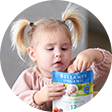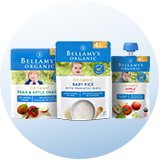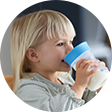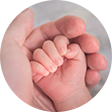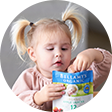Lactose Intolerance in Babies
What is lactose intolerance?
Lactose intolerance occurs when the lining of the intestine (bowel and gut) has been damaged. This damage is commonly caused by diarrhoea infected with viruses, such as the rotavirus. Babies with lactose intolerance cannot digest lactose properly and it remains indigestible in the intestine. Lactose is present in all breast milk, dairy milk and other dairy products. The build up of lactose attracts water which produces watery faeces (poo) causing diarrhoea. Very young babies often are not yet producing enough of the enzyme (lactase) which helps to digest lactose. Your baby may have lactose intolerance without ever having had infectious diarrhoea, but the enzyme will increase with age, so there is no need to stop breastfeeding unless the lactose intolerance is severe, causing dehydration or poor growth. It is preferable to continue breastfeeding if you are able, but if your doctor advises you to stop breastfeeding it is usually only for a very short time, so you will need to take steps to keep up your milk supply. This can happen if a child’s digestive system is upset by infections like gastroenteritis, which alter the lining of the stomach and small intestine. This kind of lactose intolerance is short term and usually improves after a few weeks.
Signs and symptoms
Symptoms may include:
- - Nappy rash
- - Pain and swelling in the tummy
- - Failure to settle at feeding times, coming on and off the breast
- - Failure to gain weight
- - Diarrhoea
- - Bulky, frothy and watery faeces
- - Red bottom with skin worn away in places
- - Passing wind and crying when passing faeces
- - Irritability or unsettled behaviour
- - Attachment problems during breastfeeding
Even if your baby has these symptoms, it doesn’t always mean they are lactose intolerant. Some or all of these symptoms can be common in healthy infants. If you think your baby or child has the symptoms of lactose intolerance, you should talk with your doctor for proper assessment.
How is lactose intolerance diagnosed?
If your baby has symptoms of lactose intolerance, take them to see a GP. The doctor will be able to determine if your child is lactose intolerant and rule out other conditions. They may do some investigations and recommend that you see a dietitian. It is important not to self-diagnose your child and make changes to their diet without consulting a doctor or dietitian.
How is it treated?
The treatment for lactose intolerance in babies often depends on the cause. And no matter what’s causing your baby’s lactose intolerance, it’s important to soothe and comfort your baby when they're showing symptoms. If your baby is diagnosed with lactose intolerance, a low lactose or lactose free infant formula may be recommended. If your baby is formula fed or you’re considering giving them formula, consult your GP or a dietitian before using or changing to a low-lactose or lactose-free infant formula. If a low in lactose formula is recommended, your baby could try lactose-free formula for 1 to 4 weeks and then graded back on to breast milk or a standard infant formula once there have been no symptoms for a week and the bottom has healed. Soy formula is not recommended for infants younger than six months old.
If your baby is old enough to eat solids it is important they don’t eat food high in milk content, such as yoghurt, soft cheese and custard. Cheddar and other hard cheeses are okay. For a breastfed baby, you should be able to continue breastfeeding. If you are breastfeeding your baby, even if you reduce lactose in your own diet, lactose will still be present in your breast milk. You can speak to a lactation consultant about adjusting breastfeeding to reduce the amount of lactose passed through to your baby. Your doctor may recommend giving your baby Lacteeze during feeding – discuss how this can be done with your doctor. Weaning isn’t usually recommended because breastmilk has so many nutritional benefits and lactose is good for your baby’s growth. Your child can usually tolerate a small amount of lactose, and gradually increasing it can help her body produce more lactase. After the low lactose diet, a normal diet containing lactose can usually be reintroduced in consultation with your child's doctor or dietitian. This needs to be done slowly and under supervision, over the course of a week or longer.
How to regrade?
After the low lactose diet, a normal diet containing lactose can usually be reintroduced in consultation with your child's doctor or dietitian. This process of reintroducing your baby’s normal feeding cycle is called regarding. This needs to be done slowly, over the course of a week or longer. Your baby may take between 5 and 7 days to regrade to their normal feeding cycle. Sometimes a doctor or a nurse may advise you to regrade in a shorter period of time. When regrading is complete, foods containing milk can be reintroduced. The below table is a guide to regrading for young babies. Replace one bottle of lactose-free formula with one breastfeed or bottle of usual infant formula each day for 5 days, until all lactose-free bottles have been replaced by usual feeds, as shown below. If your baby develops diarrhoea, go back one step. If it persists see your doctor.
| Day | Feeds |
| One |
|
| Two |
|
| Three |
|
| Four |
|
| Five |
|















